Solar Pond

(This is a series of articles on the various technologies that can be employed to trap the sun’s energy. This is the 8th part of the series.)
A solar pond is also another type of solar collector which is used for applications where large temperatures are not necessary. It may be used for generating heat or electricity or for desalination of water or for low temperature applications in industry and agriculture.
It works on a simple phenomenon. When water heats up a pond or lake, water rises up after getting warmed. In a solar pond, heat is trapped because salt is added, the concentration increasing with depth. Because of being heavy, it cannot rise and the heat generated by sunshine remains trapped. The temperature at the bottom of the pond will rise to over 90 °C while the temperature at the top of the pond is usually around 30 °C.
There are 3 distinct layers of water in the pond:
- The top zone or the surface zone is called the UCZ (Upper Convective Zone) and is atmospheric temperature. It has little salt content.
- The bottom zone is the hot zone also called the LCZ (Lower Convective Zone). Temperatures in the range of 70°– 85° C. It has a high concentration of salt. It energy in the form of heat.
- The zone of separation is called NCZ (Non-Convective Zone). The salt content increases in this zone as the depth increases. Water in a particular layer cannot rise as the water above it is lighter due to lower salt content and vice versa. The salt gradient also acts as an insulator trapping the sunlight.
The energy obtained is rather low grade and can generate temperatures in the range of 70-80 °C. However, larger systems can be built using no more than a membrane to cover the pond which results in much lower costs. Usually, coastal locations are good locations for such solar ponds although theoretically they can be constructed anywhere.
Advantages:
- Highly useful for rural areas because of the low cost involved.
- A separate collector system is not needed in a solar pond setup.
- The heat stored is on a very large scale and hence it can be used day and night, no storage is necessary in the form of batteries.
Disadvantages:
- Larger land area requirement is often a deterrent.
- The surface water keeps evaporating and needs to be replaced periodically.
- Large supply of salt water is needed.
- Some degree of maintenance is necessary- removing and preventing algae growth; maintain transparency in the pond and the salt gradient.
Image credit: Solar pond, http://www.solarponds.com/



